Long wait times, unhappy customers, disengaged agents, and high turnover: call center problems can have cascading effects that significantly impact your bottom line.
Whether you manage a single call center or oversee several outsourced contact centers, finding the root cause or seeing the bigger picture isn’t always easy.
In this article, we’ll cover 10 of the most common contact center issues and share actionable steps to resolve them. This way, you can tackle existing problems and proactively address potential concerns.
1. High call abandonment rate
A call abandonment rate of 12% is typically acceptable for many call centers. If most of your customers use mobile devices to call in, a rate as high as 20% might be satisfactory.
However, a much higher call abandonment rate means lots of customers are hanging up before resolving an issue or making a purchase—more than the industry average.
If your team is hitting customer satisfaction and conversion rate key performance indicators (KPIs), you might be less worried about all those unresolved calls.
Over time, though, high call abandonment rates can cause bigger problems. It can lead to unhappy customers, who might take their business elsewhere or badmouth your company.
Solution: Implement self-service options
One of the most effective ways to reduce your call abandonment rate is to provide self-service options. Interactive voice response (IVR) platforms like RingCentral and Aircall let customers navigate phone systems using voice prompts.
With IVR, customers can access resources themselves before talking to an agent. Sometimes, they can get answers without needing an agent, decreasing the demand on your call center without compromising customer satisfaction.
2. Lengthy average speed of answer
If your call abandonment rate is relatively high, your average speed of answer (ASA) is likely above industry benchmarks too. For call centers, 28 seconds is considered standard for the average ASA.
Do your customers typically wait on hold for longer than 30 seconds before speaking with an agent? If so, you’re wasting their time and potentially creating issues with customer satisfaction.
When you can’t promptly connect customers with a human, you gradually lose their trust—and might lose their business, too.
Solution: Optimize agent scheduling
In some cases, IVR can improve the average speed of answer and provide self-service options. IVR software can also automatically route calls to the correct agents.
However, IVR can only help so much without enough agents on the clock to answer phone lines. By optimizing agent schedules, you can ensure you have enough coverage so your team can answer calls faster.
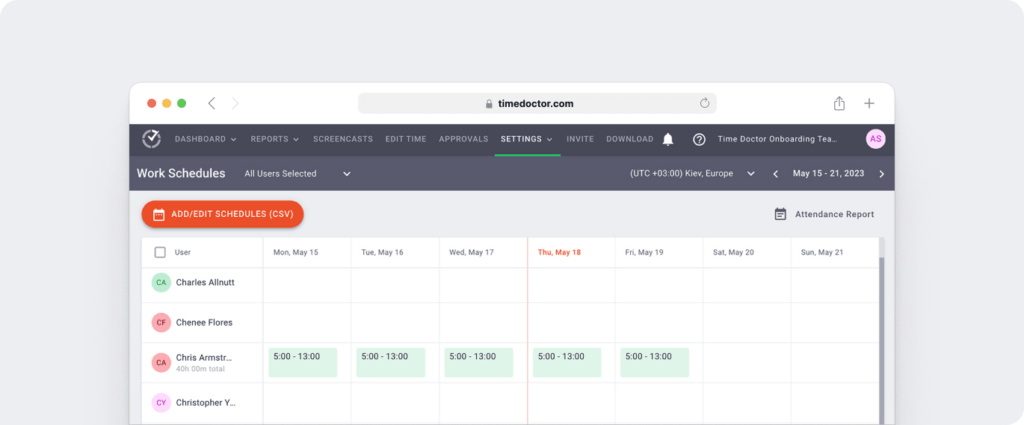
With Time Doctor, you can upload agent schedules in bulk or add one-time shifts as necessary. Then you can monitor agent attendance using auto-generated reports and insights.
3. Low first call resolution rates
No matter your industry, first call resolution (FCR) is the optimal outcome for any customer interaction. Ideally, you want to resolve customer issues on the first attempt to improve your success rates and attract advocates.
For call centers, the average FCR rate is 71%. If yours is much lower, you’re likely seeing negative customer experience trends, which affect your bottom line over time.
Solution: Improve agent scripts and resources
If customers don’t get the answers or information they need during the first call, there’s a good chance your agents don’t have access to relevant resources. By giving agents better scripts and helping them find answers more efficiently, they can improve customer service quality and resolve issues on the first try.
Call center platforms like JustCall and CallShaper can give agents scripts automatically. Both work dynamically to provide responses based on customer questions and other context.
With better scripts comes improved accuracy and more consistency. When you give agents the information they need in real time, they can provide the right response the first time.
4. Low customer satisfaction score
If your call center is juggling any of the above issues, you may also be dealing with declining customer satisfaction (CSAT) scores. Generally, CSAT scores of 80 or higher are excellent—which should be your team’s ultimate goal.
CSAT scores in the 60–80% range are still considered good. However, if they dip down to 40–60%, they’re just average—and getting close to poor.
CSAT scores measure short-term customer satisfaction, typically right after a call, email, or live chat. However, because of their close connection to specific interactions, some call center managers put less stock in their long-term impact.
If you’re serious about improving your customer interaction metrics and cultivating brand advocates over time, you need to increase your CSAT scores. Since CSAT and net promoter scores (NPS) often correlate, consider raising CSAT as a long-term investment in improving sentiment and loyalty.
Solution: Offer agent coaching and training
The first step to improving CSAT scores is collecting customer feedback about the specific issues they’re having. Platforms like Dialpad and NICE CXone can record calls for quality assurance and issue customer surveys immediately after.
The next step is reviewing the results of these surveys and spotting trends and areas for improvement. Then you can offer training and coaching for the issues that agents struggle with most.
You don’t have to wait to provide coaching or training. Often, these platforms can provide real-time coaching to help your team respond faster and better.
5. Poor agent on-time performance
Do you find you’re unable to route calls more efficiently because employees aren’t reporting to work on time or at all? Tardiness and absenteeism can become more than just scheduling issues.
Over time, they can negatively impact customer service metrics and your bottom line. If you’re taking steps to boost customer interactions, improving agent on-time performance is essential too.
Solution: Monitor employee attendance
Whether you manage an in-office, hybrid, or fully remote team, you need a system for tracking attendance. Time Doctor can automatically monitor attendance and track employee activity during work hours.
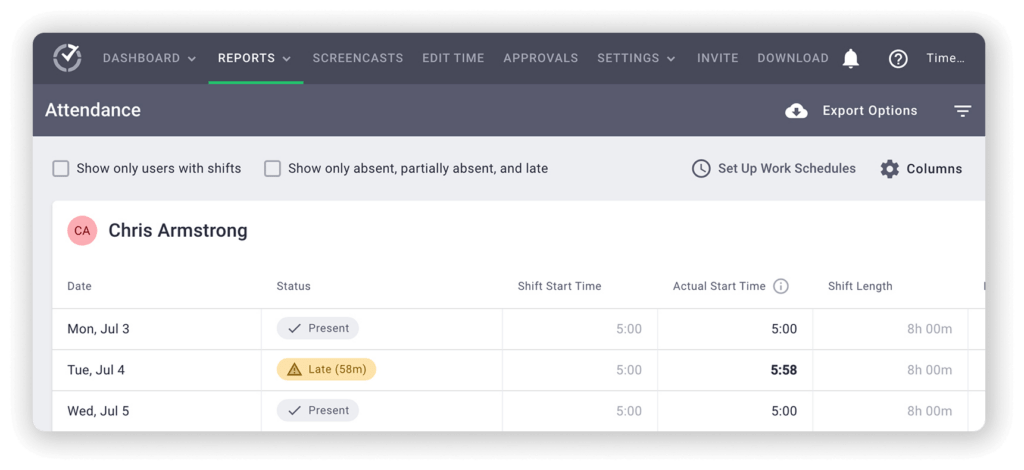
Once you input agent schedules, the platform automatically highlights late arrivals and absences. If you spot a tardiness trend, you can talk with employees to learn what’s making them late and work to address the issue together.
6. Low agent productivity
Do your agents reliably clock in on time and put in full work days but end up behind on projects or late on deadlines? If your team isn’t completing assignments as efficiently as they should be, you might have a productivity problem.
For teams that work remotely, tackling productivity issues can be particularly tough. Understanding how employees use their time isn’t easy when you don’t spend work hours in the same room.
Solution: Track idle and productive time
Get a better handle on employee productivity and performance levels with a task and time tracking tool. Time Doctor automatically monitors both aspects to tell you what your team is working on and how long it’s taking.
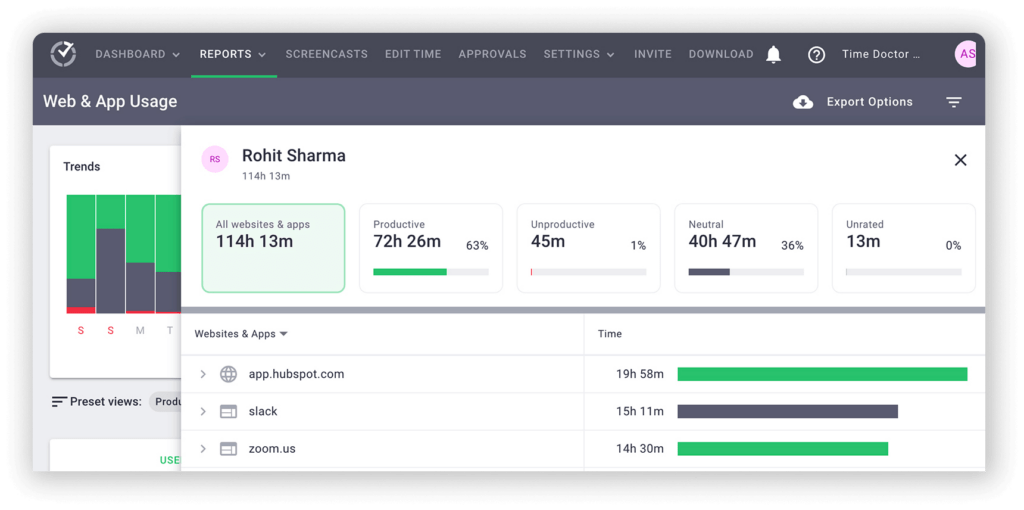
The platform also uses your custom settings to monitor productive, unproductive, and idle time. With Time Doctor’s productivity reports, you can spot trends, find the cause of productivity issues, and identify your most productive team members.
7. Low agent retention
Even the best call center agents can’t be productive 100% of the time. Contact centers are high-stress environments, and agents need balance while on the clock and between work and home.
Overworked agents may experience burnout and develop morale issues, leading to performance problems. If they aren’t receiving support or rewards at work, they may quit, forcing you to start the hiring process again.
In fact, the average turnover rate for call centers is nearly 40%, which creates an expensive and seemingly endless recruitment cycle.
Solution: Improve engagement and address work-life balance issues
To tackle employee attrition, you need to discover which team members are most likely overworked or experiencing burnout. While you can certainly listen and look for signals, having a system to detect these issues is helpful.

Time Doctor automatically identifies employees with the biggest work-life balance issues based on their work hours. Reviewing these reports alongside Time Doctor’s productivity trends allows you to spot overworked agents.
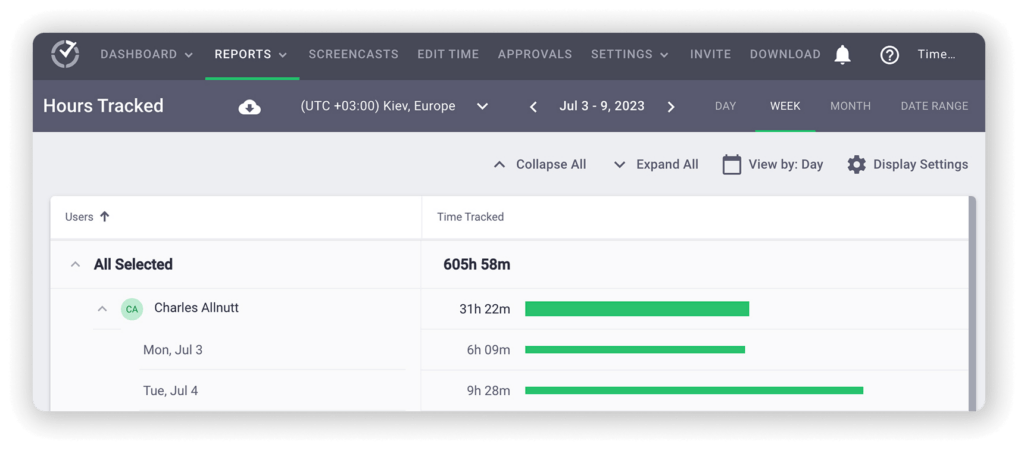
Since these insights help you see issues early on, you can take steps to talk with affected team members and improve employee engagement. You can also offer guidance or incentives to improve the employee experience.
8. Inability to scale operations
Your contact center team could be doing everything right, from answering calls efficiently to providing resolutions during the first touch and keeping employee satisfaction sky-high. The more success you see, the more you want to scale.
However, scaling a contact center can be tricky, even if you have a solid team and a proven standard operating procedure (SOP) framework. If you plan on hiring local call center agents for in-person work, you might find scaling even harder.
Solution: Offer remote opportunities instead of in-office roles
Rather than requiring in-office work and automatically limiting your hiring pool, consider building a remote call center team instead.
Managing a remote team isn’t as daunting as you think. At Time Doctor, we’ve grown our team to 100+ people across 30+ countries over the past decade.
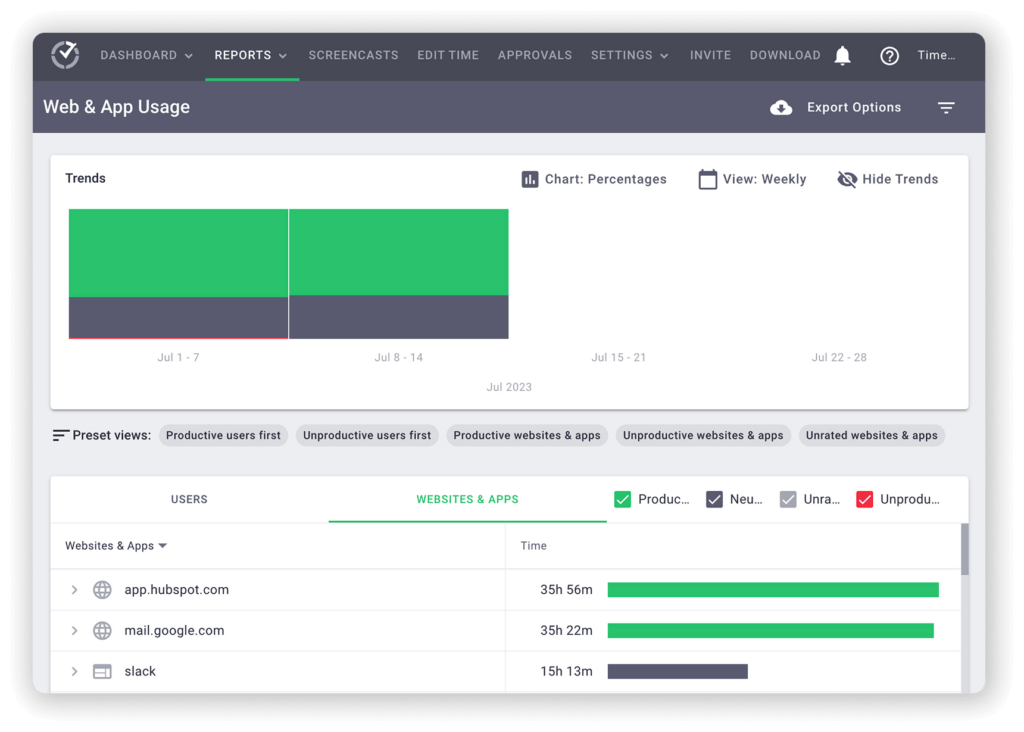
One thing that’s kept our remote team accountable is using a reliable workforce management system.
With Time Doctor’s platform, we can schedule coverage, track task and project time, and monitor productivity. Then we can see what we’re doing well or what needs improvement, even working half a world apart.
9. Inadequate performance metrics
If you suspect your contact center is struggling with high AHT, low FCR, and terrible CSAT but don’t have a way to confirm your concerns, you may have a bigger problem.
You won’t know what is or isn’t working without a method of measuring and optimizing your call center’s performance. Guesswork or haphazardly assessing agents won’t help you make much progress.
Consistently measuring call center metrics is the first step toward fixing them. After all, you need an objective way to identify common call center issues so you can take data-driven steps to improve.
Solution: Adopt a workforce management platform with advanced analytics
Scoring your team’s work and measuring their improvement requires a workforce management platform with built-in analytics. Before you choose software, make sure it measures the metrics you need.
For example, Time Doctor offers advanced time tracking, attendance, and productivity analytics, helping you monitor team performance and manage tasks.
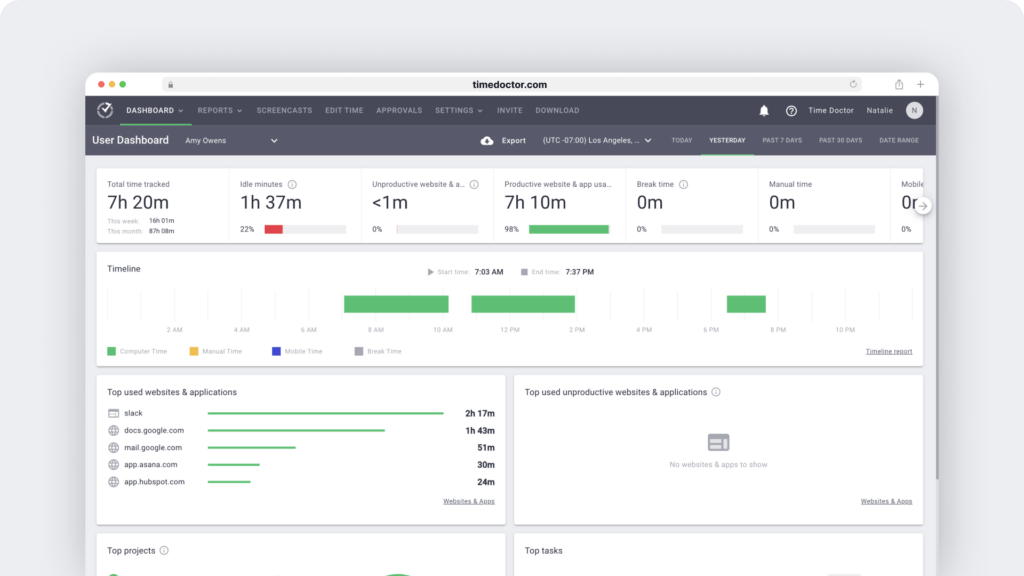
Dedicated contact center management platforms like Zendesk and Freshdesk observe agent activity so you can improve customer interactions and call times.
10. Disconnected tech stack
As your contact center staff expands and you aim to level up your operations, you likely need to adopt more platforms to do the job. If you’re scaling quickly, acquiring one-off tools that meet an immediate need rather than larger goals is easy.
Using more software isn’t necessarily bad, but having tools that don’t talk to each other can be. If your tech stack includes multiple disconnected tools, you could waste more time than you realize.
Do you frequently find yourself exporting data from one tool so you can import it into another? Do you produce reports manually by compiling analytics from multiple platforms? If so, your tech stack may be inefficient.
Solution: Use call center software with essential integrations
The easiest way to create a connected tech stack is to choose software with built-in integrations. After the initial setup, the platforms share data automatically.
For example, by using Time Doctor to manage call center employees, you have access to built-in integrations with help desk platforms. Time Doctor integrates with software like Intercom and Zoho Desk to help your team track time and manage tasks more efficiently.
Next steps for improving agent turnover and productivity
High attrition rates and poor average handle time don’t have to define your contact center. With the right workforce management platform like Time Doctor, you can automatically track agent time and activity, giving you the insights you need to increase efficiency, engagement, and retention.
Want to see how Time Doctor could improve key outcomes for your business? Request a demo and see how our software provides peace of mind and actionable insights for outsourced contact centers.

Andy is a technology & marketing leader who has delivered award-winning and world-first experiences.


